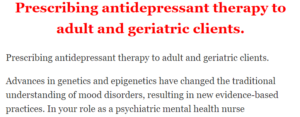Prescribing antidepressant therapy to adult and geriatric clients.
Prescribing antidepressant therapy to adult and geriatric clients.
Prescribing antidepressant therapy to adult and geriatric clients. 
Advances in genetics and epigenetics have changed the traditional understanding of mood disorders, resulting in new evidence-based practices. In your role as a psychiatric mental health nurse practitioner, it is essential for you to continually educate yourself on new findings and best practices in the field. For this Assignment, you consider best practices for assessing and treating adult and geriatric clients presenting with mood disorders.
Learning Objectives
Students will:
- Assess client factors and history to develop personalized plans of antidepressant therapy for adult and geriatric clients
- Analyze factors that influence pharmacokinetic and pharmacodynamic processes in adult and geriatric clients requiring antidepressant therapy
- Evaluate efficacy of treatment plans
- Analyze ethical and legal implications related to prescribing antidepressant therapy to adult and geriatric clients
Examine Case Study: An Elderly Hispanic Man With Major Depressive Disorder. You will be asked to make three decisions concerning the medication to prescribe to this client. Be sure to consider factors that might impact the client’s pharmacokinetic and pharmacodynamic processes.
- At each decision point stop to complete the following:
- Decision #1
- Which decision did you select?
- Why did you select this decision? Support your response with evidence and references to the Learning Resources.
- What were you hoping to achieve by making this decision? Support your response with evidence and references to the Learning Resources.
- Explain any difference between what you expected to achieve with Decision #1 and the results of the decision. Why were they different?
- Decision #2
- Why did you select this decision? Support your response with evidence and references to the Learning Resources.
- What were you hoping to achieve by making this decision? Support your response with evidence and references to the Learning Resources.
- Explain any difference between what you expected to achieve with Decision #2 and the results of the decision. Why were they different?
- Decision #3
- Why did you select this decision? Support your response with evidence and references to the Learning Resources.
- What were you hoping to achieve by making this decision? Support your response with evidence and references to the Learning Resources.
- Explain any difference between what you expected to achieve with Decision #3 and the results of the decision. Why were they different?
- Decision #1
- Also include how ethical considerations might impact your treatment plan and communication with clients.
Note: Support your rationale with a minimum of three academic resources. While you may use the course text to support your rationale, it will not count toward the resource requirement.
Review the following medications:
- amitriptyline
- bupropion
- citalopram
- clomipramine
- desipramine
- desvenlafaxine
- doxepin
- duloxetine
- escitalopram
- fluoxetine
- fluvoxamine
- imipramine
- ketamine
- mirtazapine
- nortriptyline
- paroxetine
- selegiline
- sertraline
- trazodone
- venlafaxine
- vilazodone
- vortioxetine
you can edit my work bellow, add more information , and use same medication therapy. Plagiarism must be less than 15 %
Introduction
Improving depression care for depressed older men is a public health priority because older men are less likely than older women to receive depression treatment and are also more likely to commit suicide .Depressive disorder causes a continuous feeling of worthlessness , hopelessness and unhappiness to the victim and loss of interest in what they used to enjoy doing, also call major depressive disorder (MDD) or clinical depression (Unützer & Park, 2012). 3 Depression is one of the most common mental health problem leading to disabling in older men (Unützer & Park, 2012). A Late-life depression (LLD), is referring to depression that recurs in old age (having begun earlier in life) and again late in life; this negatively affect patients cognitive impairment, functional impairment, and development of Alzheimer’s disease and vascular dementia (Diniz & Reynolds, 2014).
3 Late-life depression (LLD is associated with burden of medical illnesses (especially cardiovascular and cerebrovascular) and risk of death. Patients assessment for depression should be using a standard rating scale, and initiate effective treatment such as antidepressant medications or evidence-based psychotherapies and psychiatric follow up. Electroconvulsive therapy (ECT) (Unützer & Park, 2012) can be an alternative for patients who are not improving. Antidepressants reduce the consequences of depression. 3 It is important to note that depressed adults may be at increased risk for antidepressant adverse effects. (Diniz & Reynolds, C. F. (2014). 3 This week paper focuses the identifying and treatment of late-life depression of an Elderly Hispanic Man with history of Major Depressive Disorder (MDD)
Decision #1
1 Will start with Zoloft 25 mg orally daily
Reason for the Selection:
3 Assessment tool used is Montgomery–Åsberg Depression Rating Scale (MADRS), patient score 52, which is an indication of severe depression. When choosing an antidepressant my treatment option is based on the best side effect profile and lowest risk of drug-drug interactions Wiese, (2011). Wellbutrin is an antidepressant, but can cause seizures and Effexor may increase blood pressure Wiese, (2011). Zoloft is one of the most effective and safest medication for the treatment of severe depression in adults (Flint & Rifat, 2013. My best option is Zoloft 25mg which is best choice because of harmless to the elder (Flint & Rifat, 2013). Antidepressant use in the elderly are thought to be due to changes in hepatic metabolism with aging, concurrent medical conditions, and drug-drug interactions (Wiese, B. 2011). 3 (Flint & Rifat, 2013).
Expected Results
The patient should be able to improve within two weeks. Some signs should might be am improve in his work, exercise, hobbies, intellectual pursuits, as well improve sleep. 3When using Zoloft, the level of awareness should improve. It must be noted that the patient is back on track with motivation to follow his normal activities and relate well with associates (Flint & Rifat, 2013).
1 Differences between Expected Results and Actual Results
3 Expected outcome after the use of Zoloft 25mg is the patient will see improvement in his mental capability and importantly that there was no side effect of the medication.The patient revisited after four weeks on his follow up appointment and reported of a decrease in the symptoms, but with a complain of sexual dysfunction and insomnia. The difference in the expected result and the outcome may be reason out that the body of the patient is trying to adjust to the medication while solving the problem of MDD (National Alliance on Mental Illness, 2017).
1 Decision Point Two
Selected Decision: 1 Augmenting agent such as Wellbutrin XL 100 mg in morning
Reason for Selection
3 The added augmenting agent such as Wellbutrin XL150mg in morning was because the patient has some complain of having decrease sex drive, impotence, or difficulty in having an orgasm and sleep problem (insomnia). Bupropion is an antidepressant with excellent tolerability in elderly person improve depression, insomnia, somatic symptoms, work functioning, and certain quality-of-life measures in elderly depressed subjects with medical disorders (American Psychiatric Association, 2013). Though, patient verbalized decrease in the depression symptoms because of using Zoloft, but because of decrease sex drive and insomnia, Zoloft will be decrease to 12.5mg orally every day and continue to watch for side effects, like suicidal tendency in the elderly, and complain about ejaculatory and sexual dysfunction (American Psychiatric Association, 2013).
Expected Results
3 With the combination of using Wellbutrin and Zoloft, it is still expected to see the patient to continue to experience reduction in depression symptom. The therapeutic effect should be observable which will motivate and encourage the patient.
1 Differences between Expected Results and Actual Results
3 The expected outcome after four weeks visitation is that the therapeutic effect of the medication will be clear and no more report of adverse reaction, that shows patient is tolerating the medications as agree. The actual result was that the patient report that there was more reduction in the MDD symptom and improved in the side effect which is insomnia and sexual dysfunction.
Decision Selected
1 Decision Point Three
3 Selected Decision I will discontinue Zoloft 12.5mg orally daily and increase the dosage of Wellbutrin to 150mg XL every morning.
1 Reason for Selection
3 The desire result was not obtained in the second stage though the patient observe reduction in the symptom of MDD, but the resulting side effect is not reducing or eliminated. Wellbutrin XL can help to reduce depression and remove most of the side effect of Zoloft (Mangoni, & Jackson, 2004), also this will help attain therapeutic effect with his symptoms until his next appointment to evaluate response to therapy (Mangoni, & Jackson, 2004). The patient will have to be monitor closely because of the medication adjustment side effect, the suicidal tendency (Mangoni, & Jackson, 2004).
Expected Results
3 At this point the patient is anticipated to experience close to zero symptom of major depressive disorder without any side effect, the sleeping problem or insomnia, sexual dysfunction. He is also expected to have good interaction with neighbor and friends.
1 Differences between Expected Results and Actual Results
Wellbutrin 150mg XL, there is a solution in the treatment of the patient with MDD, (Laureate Education, 2016). 3 When the medication is working well with no side effect, patient will continue with Wellbutrin XL 150mg orally daily dose and will be re-evaluated during the next appointment, medication can be increase if there is a reduction in symptoms to achieved desired maximum therapeutic effect. The actual result from the patient is that the medication is achieving the therapeutic effect that is needed by the patient (Mangoni, & Jackson, 2004).
1 Impact of Ethical Considerations on Treatment Plan
3 Ethical Considerations on treatment plan of a psychiatry patients can be complicated which can arise from plan therapy.Addressing the side effects of medications should be the most important in the plan of this therapy which include suicidal tendencies, dosage adjustment and close monitoring for effects (Flint & Rifat, 2013. Some drugs can cause patients to have suicidal tendencies (Flint & Rifat, 2013. Ethically there are sometimes practitioner are being influence by the health insurance of the patient, that is it easier to have a claim for drug treatment than physical therapy, therefore the health professional will choose to go the route of drug treatment. In all consideration the beneficence and no maleficence principles must be observe, the best treatment and best drug that sooth the patient must be administered.
Conclusion
When treating patients, we must understand that some drugs are good for a patient but the side effect on the patient might be grave. A careful treatment and monitoring of patients is important for total healing (NAMI National Alliance on Mental Illness, 2017).
References
4 American Psychiatric Association. (2013). 3 Diagnostic and statistical manual of mental
disorders (5th ed.). Washington, DC: Author. Note: 3 Retrieved from Walden Library databases.
Diniz, B. 3 S., & Reynolds, C. F. (2014). 3 Major Depressive Disorder in Older Adults:
Benefits and Hazards of Prolonged Treatment. Drugs & Aging, 31(9), 661–669.http://doi.org/10.1007/s40266-014-0196-y
Flint, A. 3 J., & Rifat, S. L. (2013). 5 The effect of sequential antidepressant treatment on
geriatric depression. 3 Journal of affective disorders, 36(3), 95-105.
Laureate Education. (2016g). Case study: 1 An elderly Hispanic man with major depressive
disorder [Interactive media file]. Baltimore, MD: Author.
Mangoni, A. 3 A., & Jackson, S. H. D. (2004). 3 Age-related changes in pharmacokinetics and
pharmacodynamics: 3 basic principles and practical applications. British Journal of Clinical Pharmacology, 57(1), 6–14. Retrieved from: 3https://www.ncbi.nlm.nih.gov/pmc/articles/PMC1884408/
6 National Alliance on Mental Illness. (2017). 3 What Is Sertraline and What Does It
Treat? Retrieved from: 7 https://www.nami.org/learn-more/treatment/mental-health-medications/sertraline-(Zoloft)
Unützer, J., & Park, M. (2012). 3 Older Adults with Severe, Treatment-Resistant
Use the following coupon code :
premiernursingpapers



